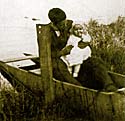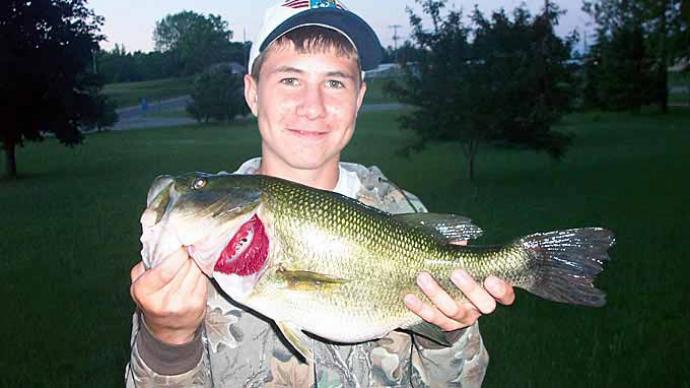
Richmond Mill Lake, near Laurel Hill, in eastern and south North Carolina, is steeped in history. There are more rich historical tales surrounding this lake than probably any in the United States. But, what is about to happen may be the best story yet. A new chapter in history is being written.
Richmond Mill Lake is about to become a cutting edge fishing club. An old lake is being transformed into a premier bass lake for members. With bass architect Ray Scott employing his 40 years of fishing knowledge to redefine the lake bottom with custom-built big bass structure, the stage is set for this lake to be a world-class largemouth bass fishery. Scott, of B.A.S.S. fame, founded a company called Legacy Lakes, where he and his experts come in and not only consult how to make a great bass lake, they can do the job turn key. Imagine a lake designed by Ray Scott, with a world class fishing club. The parallel is a Jack Nicklaus designed golf course and club. Scott and Richmond Mill Lake owners spell success "F.I.S.H."
Here's the story.
The 120 acre sandy bottom lake was built in 1835 by Charles Malloy. It was used as an energy source, waterpower harnessed for a sawmill. With thousands of gallons of water cascading across the spillway hourly, there was more than enough energy to power the mill.
During the Civil War, an island in the lake was used as a safe haven for local residents, who faced General Sherman's marching onslaught. The island protected livestock and household goods from harm's way until Sherman and his troops moved on. After the war, since Confederate money was no good, Malloy received as payment on a debt, textile mill equipment recovered from a sunken blockade runner in Wilmington Harbor. The machines had been wet, recovered and sat on a railroad dock for several years. Malloy had issues trying to use the equipment, so ran a want ad in the local paper for someone with mechanical knowledge. Mark Morgan answered the ad.
In 1872, the Morgan family moved to the area. Several years later, after Malloy's death, Mark Morgan bought the lake and surrounding acreage, accumulating somewhere around 4,000 acres. Over the next century, land uses were defined, then redefined. Virgin longleaf pines were harvested and made into lumber, some of which still resides in nearby buildings. Longleaf pine trees were harvested, planted, harvested again, replanted. Some of the land was cleared for crops, and even today lessees or sharecroppers are farming that same land.
While the agricultural prospects helped put food on the table, the lake was a focal point. In the late 1800's, Mark Morgan decided to bring the family investment portfolio into the textile mill business. Richmond Mill Lake became a point of recreation for the entire community. At its peak, textile mills owned by the Morgan family employed 1500 people. For eighty years, the community worked, lived, played and shopped. The Morgan Company provided work, recreation, housing and a company store. The paradigm was defined. Mark Morgan died in 1916, then passed the company to his grandson, Edwin, in 1923, who built the mills into their peak. Not only did the Morgan Company mill the cotton, they grew much of what they milled.
Then, in the 1960's, the paradigm shifted. Three generations downstream Edwin Morgan made a company decision which proved to be prophetic for the community and his family. The decision took courage, lots of it. Mr. Morgan decided to sell the mills. He closed the textile chapter of eighty years of family history with the stroke of pen on contract. The decision proved financially sound. By the 1980's, foreign competition was pushing mill profits south. Today, most of the foreign-owned mills have closed, imploding in an economy focused on lower labor costs abroad.
With proceeds of the sale safely invested in other assets, the Morgan Company downsized to a handful of loyal family members and employees.
Sailing was smooth.
In the late 1990's, into the 21st century, Richmond Mill Lake was still considered a private lake gone public. The Morgan family saw their tradition-rich lake as the least they could do for a loyal community of workers several generations deep. Even though the mills have been closed for decades, the community still sees the lake as a birthright, for their own personal use.
The paradigm is shifting, again.
The lake, long considered a non-performing asset, was in dire need of an income producing makeover. Since the lake had never earned a dime on its own, management has decided to figure out how to balance the profit and loss statement.
Enter Jim Morgan, the sixth generation leader of Morgan Company. After 20 years in the ministry, Dr. Morgan stepped outside the pulpit into the boardroom at his father's request. Dr. Morgan's dad, Jimmy Morgan, Edwin's son, has held the reins for years and was ready to step away a few steps. A man of faith, Jim Morgan is making bold decisions in the mold of his grandfather and father before him.
Jim Morgan is passionate. He loves God, family, music, baseball and...fishing.
Four years ago, the Morgan Company made a routine inspection of Richmond Mill Lake's dam. With a new set of standards enacted by the legislature due to damage caused during recent violent hurricanes pummeling the state, dam inspectors are doubly vigilant in their pursuit of safety.
The pursuit of safety is of utmost importance to the Morgan Company. They had routine inspections yearly, at their own expense.
The resulting news this time was devastating. Their dam was deemed unsafe, and the lake was ordered drained for repairs to the dam. Furthermore, the State of North Carolina mandated how the dam was to be resurrected.
Professional engineers were hired to evaluate, redesign and oversee reconstruction.
While the Morgan Company embraced the State's new requirements, they weren't prepared for the consequences.
Costs were staggering and something had to be done.
Morgan and his long-time right-hand man, Dave Buhler, have looked at a number of options. Day fishing, simply charging for the right to fish...that looked attractive in the beginning. How about building a conference center, to attract trade dovetailing off nearby world class golf courses like Pinehurst No. 2 or Southern Pines? Maybe using the lake as a recreational activity point for nearby retirement homes?
Many other options were discussed as well, but after running the projections, those numbers didn't add up. Plus, for some of the choices, the risks were too high.
The next idea was to form a first class fishing club with a limited membership. Why not?
The financial model looks strong. The idea is not only viable, but similar clubs have been in existence for more than 100 years in other states. One huge difference here, though. This club will have one owner and a given number of selected members who enjoy the benefits of a great fishing lake, outstanding accommodations and a benevolent corporate rule structure. Members write a check, and fish a Ray Scott designed bass lake, intensely managed for quality fishing.
Although the lake wasn't built as a fishing lake, it has provided some outstanding catches during its lifespan. With proper stocking and management, this lake will reach its potential.
After draining, soils that haven't seen the light of day since 1835 have received a much welcome breath of fresh air. A fast-moving stream of water continually meanders through the dry lake bottom, following a channel carved many, many years ago. The lake bottom was riddled with thousands of tree stumps, tops long ago rotted and gone. Morgan and Buhler recognized the lake bottom had too much structure, so they researched for weeks and decided to rid the lake of it stumps, then redesign the lake bottom with thoughtful structure by Ray Scott.
The marriage between Morgan Company and Ray Scott makes perfect sense. Both are passionate about fishing. Both are committed to excellence. Both are excited about the timing of this project.
Scott is excited, like a youngster on Christmas morning. "Six or seven times more people fish than play golf," Scott said. "That's a huge market." He continues, "We can accommodate all types of fishermen at this club. If a member wants to fish for big bass, they can do it. If a youngster is in the boat, they will be able to drop a cricket under a bobber and catch big bream."
Playing off his years experience in the fishing industry, Scott's feelings run deep. "Our industry has chummed and charmed the public for years that they need a big, fast boat to catch a fish. But, the fact is the industry isn't growing at the same rate as the population." He goes on, "I can see young boys, watching fishing shows on TV, bowl of dry cereal in their lap and thinking, 'When I get to be a big boy, I'm going to have a big boat and go fishing.'" Scott has a valid point.
The pond and lake management business has grown because more people are looking for better ways to utilize private waters. Public lakes are not becoming less crowded. Far from it. Private lakes are a great alternative. Well managed lakes simply produce more fish, and better quality fish. Another plus is exclusivity. Private waters beckon privacy.
What about the fishery of Richmond Mill Lake? Jim Morgan chimes in. "This lake has every advantage any lake could possibly have. The best structure, the best stocking rates, the best management plan, fresh water. It's fishable, and has a history of good fish."

Scott adds, "When you watch a fishing show, there's a bias. Not all bass start at seven pounds. God loves smaller bass more than bigger bass because he made more of them." Where's he going with this? "In order to grow huge bass, you need a thoughtful management plan which not only takes into consideration a food chain, but also selective harvest. This club will focus on continually producing a great fishery, including all sizes of bass."
No doubt Richmond Mill Lake has its challenges. It has a huge flow rate of acidic water going through every day. Lime it? Doesn't make much sense. Too much flow. Fertilize it? Same answer. So, how do you take a flow-through freshwater lake with a pH of 5.3 and make it a great fishery? Think outside the box. With soft, acidic water one concern is providing the basis of a long-term food chain. Since nature has provided an obstacle, Morgan Company managers have a plan to overcome it. They plan to provide a thoughtful feeding program for all fish. That means automatic feeders spread strategically around the lake. It also means hatchery ponds on the property growing big numbers of baitfish for periodic stocking, as needed.
Let's see...a fishing club, with a long-term commitment to excellence through thoughtful management, fish structure designed and installed by the father of bass fishing, exclusivity...hmmm, what else could there be?
Ah, glad you asked.
Buhler, the daily hands-on guy, adds his thoughts. "One other thing that stands out about this project is the setting. We have beautiful setting, nestled in tall pines, with a scenic lake which is attractive to all types of wildlife. When we are in a boat, enjoying the outdoors, you never know what you might see. We have wood duck houses. An occasional Osprey makes its way around. We see waterfowl, and many birds. And, you might see different animals coming in for a drink. And, of course, this part of the country has plenty of greenery around the shores. It's as natural a spot as nature can offer."
Scott adds this parting shot. "We are creating a model of the finest fishing anyone can dream of. It will be challenging and you will be tested. Richmond Mill Lake won't be like shooting fish in a barrel. The average man wishes he could be like Bill Dance, but knows he can't. But, in this lake, we are making the experience of fishing and all of nature come into harmony. We encourage the habitat to not only be perfect for fish, but for all of nature."
This is not only an exciting opportunity for the participants, but for everyone interested in pond management. It's definitely a paradigm shift for the Morgan Company, but it also may prove to be a shift in thinking for other landowners around the country.
The club has a tentative target date of March, 2006 to open its doors.
Stay tuned.
Reprinted with permission from Pond Boss Magazine




